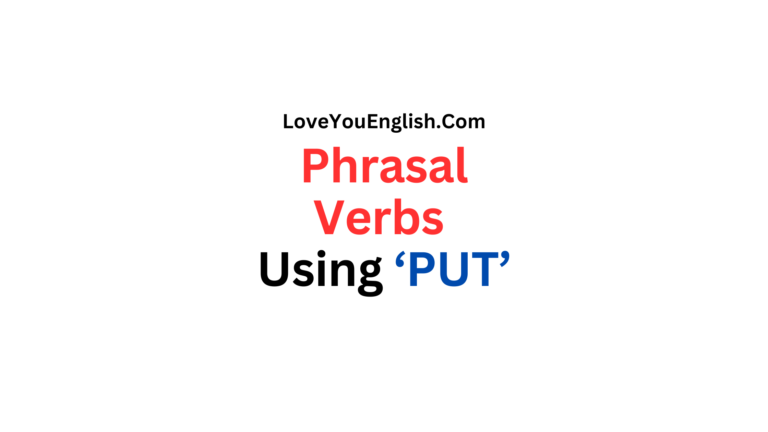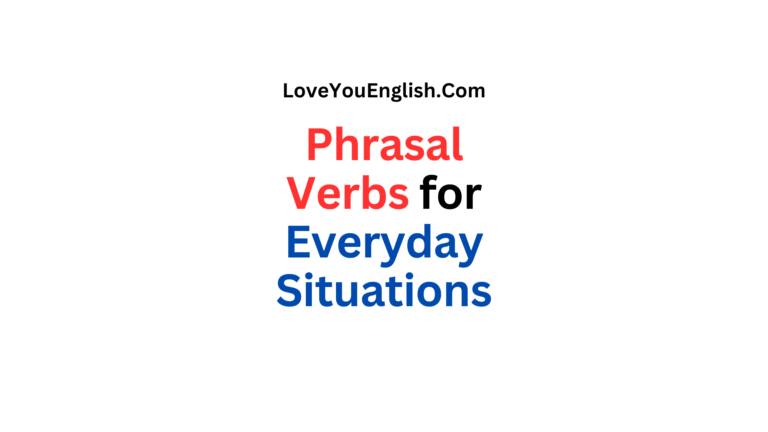The Difference Between Phrasal Verbs and Idioms
When learning English, you’ll often come across expressions that seem strange or confusing at first. Two common types of expressions that can be tricky are phrasal verbs and idioms. Though they may sound similar, they are actually quite different.
In this post, we’ll take a closer look at both phrasal verbs and idioms, explain what they are, and highlight the key differences between them. I’ll also share some examples to help you understand how to use them in everyday conversations.
What are Phrasal Verbs?
Phrasal verbs are combinations of verbs and one or more particles (prepositions or adverbs) that create a new meaning. These particles are key to changing the meaning of the verb. The meaning of a phrasal verb can often be quite different from the meaning of the individual words.
For example:
- Look up: To search for something (e.g., looking up a word in the dictionary).
- Give up: To stop trying (e.g., “I won’t give up on my dreams”).
- Turn off: To stop something, usually by pressing a button (e.g., turning off the lights).
In these examples, you can see how the verb’s meaning changes when combined with the particles up, give, and off. Sometimes the meaning is very clear, but in other cases, it can be confusing without context.
Types of Phrasal Verbs:
- Separable Phrasal Verbs: You can separate the verb and the particle with the object of the sentence.
- Example: Turn the light off or Turn off the light.
- Inseparable Phrasal Verbs: The verb and the particle stay together, and you cannot separate them with the object.
- Example: Look after (e.g., She looks after the kids).
Why Are Phrasal Verbs Important?
Phrasal verbs are important because they are used in everyday speech and writing. Native speakers use them frequently, so understanding and using them can make your English sound more natural. Additionally, knowing phrasal verbs can help you understand what others are saying, as they appear often in conversations, TV shows, movies, and books.
What are Idioms?
An idiom is a phrase or expression that has a meaning that is different from the literal meaning of the individual words. Idioms are often cultural, and they can be tricky because their meanings aren’t obvious based on the words used.
For example:
- Break the ice: To make people feel more comfortable in a social situation (e.g., She told a funny story to break the ice at the party).
- Piece of cake: Something that is very easy to do (e.g., The test was a piece of cake).
- Bite the bullet: To do something difficult or unpleasant that you’ve been avoiding (e.g., I had to bite the bullet and finish the project).
In these examples, the meanings are not connected to the literal meanings of the words. Breaking the ice has nothing to do with ice or breaking it, and a piece of cake doesn’t actually refer to dessert.
Why Are Idioms Important?
Idioms are an essential part of everyday language. They add color and expression to conversations, and knowing them will help you sound more like a native speaker. While you can sometimes guess the meaning of an idiom from context, they can be confusing for learners of English. Many idioms don’t make sense when translated directly into other languages.
Key Differences Between Phrasal Verbs and Idioms
Now that we’ve explained what phrasal verbs and idioms are, let’s look at the main differences between them. Understanding these differences will help you use both correctly in your English studies.
1. Structure:
- Phrasal Verbs: A phrasal verb consists of a verb and one or more particles (prepositions or adverbs). The meaning is often a combination of the verb and the particle.
- Idioms: An idiom is a phrase where the meaning of the whole expression is different from the meanings of the individual words. Idioms do not follow a set pattern, and the individual words don’t give you clues about the meaning.
- Example: Break the ice (to make people feel more comfortable).
2. Meaning:
- Phrasal Verbs: The meaning of a phrasal verb is usually a direct combination of the verb and the particle. In many cases, it’s easier to figure out the meaning of a phrasal verb because the components still give you some clues.
- Example: Turn off (to stop something by pressing a button).
- Idioms: The meaning of an idiom is not connected to the individual words at all. Often, idioms are figurative and require cultural knowledge to understand.
3. Flexibility:
- Phrasal Verbs: Phrasal verbs are flexible and can often be used in different ways, depending on the context. They might change slightly depending on the form of the verb (e.g., past tense, present continuous, etc.).
- Example: I’ll look up the number (future tense) or I looked up the number (past tense).
- Idioms: Idioms are less flexible. The exact phrase is usually fixed, and changing the words can change or completely lose the meaning.
4. Usage:
- Phrasal Verbs: Phrasal verbs are commonly used in both formal and informal situations. They can be found in both written and spoken English.
- Example: Pick up (informal, e.g., Can you pick up the groceries?) or Carry out (formal, e.g., The study was carried out last year).
- Idioms: Idioms are generally more common in informal conversations. They are often used to add color and personality to speech or writing, but they may not be suitable for formal settings.
- Example: Spill the beans (informal, e.g., He spilled the beans about the surprise party).
Examples of Phrasal Verbs and Idioms
To help make the differences clearer, here are a few more examples of each:
- Give up – To stop trying (e.g., She gave up after failing the test three times).
- Set up – To arrange or organize (e.g., They set up the meeting for tomorrow).
- Pick up – To collect something or someone (e.g., I’ll pick up the kids from school).
- Break down – To stop working (e.g., The car broke down on the highway).
- Hit the nail on the head – To say something exactly right (e.g., You hit the nail on the head with your idea).
- Under the weather – To feel ill (e.g., I’m feeling a bit under the weather today).
- Cost an arm and a leg – To be very expensive (e.g., The new phone costs an arm and a leg).
- Burn the midnight oil – To work late into the night (e.g., She had to burn the midnight oil to finish the project).
How to Use Phrasal Verbs and Idioms
- Phrasal Verbs: It’s essential to learn phrasal verbs because they are used in daily conversations and writing. Try to focus on understanding the meaning of the verb-particle combination and practice using them in sentences. For example, you might start with simple phrasal verbs like wake up, give up, or turn on before moving to more complex ones.
- Idioms: While idioms are fun to use, remember that they don’t always translate well between languages. To master idioms, pay attention to how native speakers use them in context. Watch movies, listen to podcasts, or read books to hear idioms in action.
Conclusion
In conclusion, phrasal verbs and idioms are both essential parts of the English language, but they have different structures and uses. Phrasal verbs are combinations of verbs and particles that change the meaning of the verb, while idioms are phrases whose meanings are not related to the individual words.
By understanding the differences and learning how to use both, you can improve your English and sound more natural in conversations. Keep practicing, and soon you’ll be using phrasal verbs and idioms with ease!
Read more:
- Tips for Successful Online Video Interviews
- How To Make a Great Impression in a Job Interview
- 10 Communication Skills for Your Life and Career Success
- 2025 Interview Question: “Tell Me About Yourself”
- How to Ace an Interview: 15 Tips from a Career Coach
- How to Become a Digital Nomad







